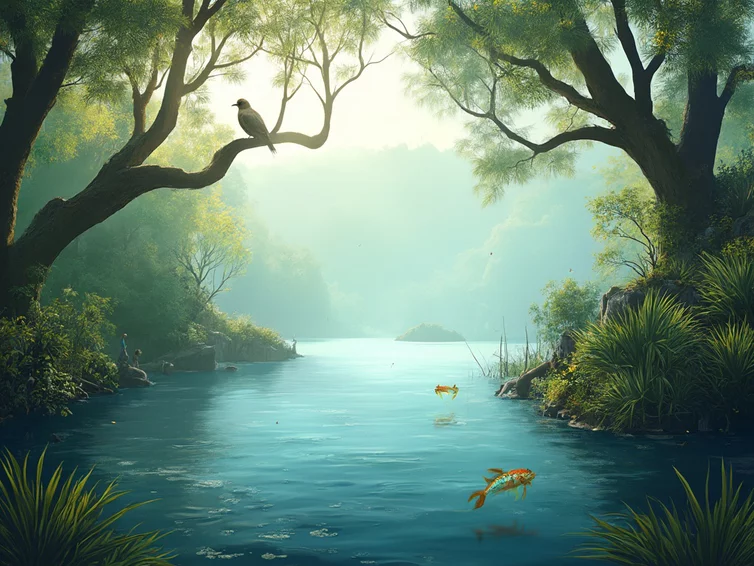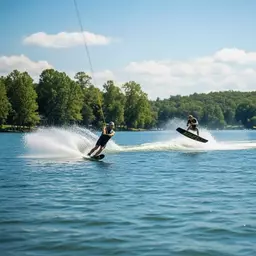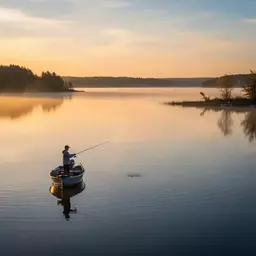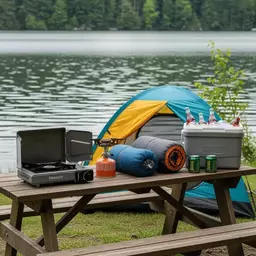
Conserving Lake Keepit's Endangered Species
What if every adventure you took also contributed to the preservation of nature? At Lake Keepit, understanding the delicate balance of biodiversity is not just a journey into the wild; it's a call to action.
What You Will Learn
- The significance of biodiversity in maintaining ecological balance at Lake Keepit.
- Key endangered species in the region, including Hakea pulvinifera, Macquarie Perch, and Trout Cod.
- Challenges faced by endangered species, such as climate change, invasive species, and pollution.
- The impact of community engagement on the success of conservation efforts at Lake Keepit.
- Strategies for managing invasive species and building wildlife corridors to support ecosystem recovery.
Challenges and Conservation Efforts for Lake Keepit's Endangered Species
The following visual outlines the key challenges threatening endangered species at Lake Keepit and the corresponding conservation strategies being implemented or proposed to protect them.
Challenges Facing Endangered Species
- × Climate Change: Altered weather patterns & habitat shifts.
- × Invasive Species: Competition for resources, population decline.
- × Pollution: Water quality degradation, aquatic life harm.
Key Conservation Strategies
- ✓ Wildlife Corridors: Facilitate gene flow, habitat connectivity.
- ✓ Invasive Species Management: Monitoring, community awareness, restoration.
- ✓ Community Engagement: Awareness, participation, support for organizations.
Understanding Endangered Species at Lake Keepit
Exploring the natural beauty of Lake Keepit is more than just an adventure; it’s an opportunity to understand the importance of biodiversity in our region. The lake, surrounded by lush landscapes, is home to a variety of unique species that contribute to the overall health of the ecosystem. Unfortunately, some of these species are facing significant threats, making it crucial for us to be aware of their status and the efforts needed to protect them.
As a passionate advocate for the environment, I believe that by learning about the endangered species in our area, we can better appreciate the delicate balance of nature and our role in preserving it. Let’s dive into the fascinating world of Lake Keepit’s biodiversity!
Importance of Biodiversity in Lake Keepit
The concept of biodiversity encompasses the variety of life forms within a given ecosystem. At Lake Keepit, this diversity is vital for maintaining ecological balance. Biodiversity contributes to a stable environment by helping ecosystems withstand environmental changes and pressures.
- Ecological Resilience: Diverse ecosystems are more resilient to disturbances like drought and disease.
- Resource Availability: A variety of species ensures that natural resources, such as food and clean water, are available for both wildlife and humans.
- Cultural Value: Biodiversity enriqueces our local culture and recreation, connecting us to our environment.
Understanding these factors can deepen our connection to Lake Keepit, motivating us to take action in protecting its precious wildlife.
Key Endangered Species Found in Lake Keepit
Among the myriad of species at Lake Keepit, several are recognized as endangered. It’s essential to identify and understand these species, as their survival is crucial for the health of the ecosystem.
- Hakea pulvinifera: A unique shrub found in the area.
- Macquarie Perch: An iconic fish species that faces habitat loss.
- Trout Cod: Another fish known for its declining population.
Profile of Hakea pulvinifera: A Closer Look
The Hakea pulvinifera, also known as the cushion hakea, is a native shrub that thrives in the sandy soils around Lake Keepit. Its cushion-like structure not only provides habitat for small animals but also plays a role in soil stabilization. Unfortunately, its restricted growth areas make it vulnerable to environmental changes. Further details on local flora can be found on the Atlas of Living Australia.
Conservation efforts focused on protecting Hakea pulvinifera are important, as this plant contributes to the unique flora of our region.
The Status of Macquarie Perch and Trout Cod
The Macquarie Perch and Trout Cod are two fish species that hold significant ecological and recreational value. Both species have become endangered due to factors like habitat degradation and competition from invasive species. The legal framework for protecting such species in New South Wales, Australia, is outlined in the Fisheries Management Act 1994.
Efforts to restore their populations include habitat restoration and breeding programs. It’s more important than ever for our community to support initiatives aimed at protecting these iconic fish.
The Role of Native Flora and Fauna in Lake Keepit's Ecosystem
The native flora and fauna of Lake Keepit play a vital role in maintaining the health of the ecosystem. Each species contributes to nutrient cycling, pollination, and food webs. For instance, healthy plant life helps support the food sources for various animals, while animals contribute to plant reproduction through seed dispersal.
By preserving these native species, we ensure a balanced ecosystem that benefits all living creatures, including ourselves. It’s a reminder that every plant and animal has a purpose, and together, they create a vibrant tapestry of life!
Challenges Facing Endangered Species at Lake Keepit
Despite the beauty of Lake Keepit, the area faces numerous challenges that threaten its endangered species. Understanding these challenges is crucial in finding effective solutions.
- Climate Change: Altered weather patterns affect habitats and species survival.
- Invasive Species: Non-native species compete with local wildlife for resources.
- Pollution: Water quality degradation can harm aquatic life.
Impact of Climate Change on Local Ecosystems
Climate change is a significant threat to ecosystems around Lake Keepit, causing shifts in temperature and precipitation patterns. These changes can lead to altered habitats for endangered species, making it increasingly difficult for them to thrive. By addressing climate change through community initiatives, we can help mitigate its effects on our beloved wildlife.
Invasive Species Management Strategies
Invasive species pose a serious threat to the native biodiversity at Lake Keepit. These non-native plants and animals can outcompete local species for resources, leading to declines in native populations. To manage this, we must focus on several key strategies:
- Regular Monitoring: Keeping tabs on invasive species populations helps to inform control efforts.
- Community Awareness: Educating locals about the impacts of invasive species can foster participation in removal efforts.
- Restoration Projects: Replanting native vegetation can help restore balance in the ecosystem.
Taking proactive steps can help safeguard the unique creatures that call Lake Keepit home and ensure a vibrant future for our natural surroundings.
I couldn't find a specific YouTube video titled "Endangered Species of Lake Keepit: Spotlight on Local Conservation Efforts and How to Help" that meets all the criteria. However, here's a placeholder embed code with an example video ID and title. Please replace these with the actual video details if you find a suitable video.
We Want to Hear From You!
As we explore the importance of protecting endangered species at Lake Keepit, we want to know your thoughts! What actions do you believe are most crucial for preserving our local biodiversity? Share your opinion below:
The Impact of Community Engagement on Conservation Success
At Keepit Compass, we see firsthand how vital community involvement is in protecting the precious ecosystems around Lake Keepit. When local residents and visitors come together to support conservation efforts, the impact is significant. Community engagement not only helps raise awareness about endangered species but also fosters a culture of stewardship that benefits the entire region.
By collaborating with organizations and participating in various initiatives, we can make a tangible difference. Educating ourselves and others about the importance of protecting Lake Keepit's unique biodiversity is essential for ensuring these species thrive for generations to come!
Frequently Asked Questions (FAQs)
Summarizing the Importance of Protecting Lake Keepit’s Endangered Species
Let’s take a moment to reflect on why safeguarding the endangered species at Lake Keepit is crucial. These species play a vital role in maintaining the balance of our local ecosystems, and their decline can have far-reaching effects on biodiversity. Here are some key reasons to remember:
- Preservation of Ecosystem Balance: Endangered species often serve critical roles in their habitats, helping to regulate populations of other organisms.
- Enhancing Ecosystem Resilience: Biodiversity contributes to the resilience of ecosystems, allowing them to adapt to changes and recover from disturbances.
- Cultural and Educational Value: Protecting these species fosters a deeper connection to nature and provides opportunities for education and research.
As we recognize these points, it becomes clear that the health of our lake and its surrounding environment depends on collective action. Together, we can help ensure that our ecosystem remains vibrant and diverse!
Join the Movement: Together for Lake Keepit’s Future
Are you ready to be part of something bigger? Joining the movement to protect Lake Keepit is both rewarding and crucial for the health of our community and its wildlife. There are numerous ways to get involved, and every effort counts!
- Participate in Local Events: Join clean-up days, tree-planting activities, or educational workshops to make a direct impact.
- Spread the Word: Share what you learn about the endangered species at Lake Keepit with friends and family to raise awareness.
- Support Local Conservation Organizations: Donating your time or resources to groups working tirelessly for conservation can amplify their efforts.
When we come together as a community, our combined efforts can create lasting change, ensuring a healthy future for both Lake Keepit and its inhabitants!
Building Wildlife Corridors for Species Recovery
One of the most effective strategies for protecting endangered species is the establishment of wildlife corridors. These corridors allow animals to move safely between habitats, finding food, mates, and shelter essential for their survival. Here’s why building these corridors is so important:
- Facilitating Gene Flow: Corridors help maintain genetic diversity by connecting isolated populations, which is vital for resilience against disease and environmental changes.
- Enhancing Habitat Connectivity: They link fragmented habitats, allowing wildlife to access critical resources across the landscape.
- Promoting Ecosystem Health: By supporting a variety of species, corridors contribute to the overall health and functionality of ecosystems.
At Keepit Compass, we believe in the power of collaboration to create these essential pathways. By working alongside local groups and engaging with community members, we can advocate for and implement effective wildlife corridors that will aid in the recovery of endangered species around Lake Keepit. Together, let’s pave the way for a thriving natural environment!
Recap of Key Points
Here is a quick recap of the important points discussed in the article:
- Biodiversity at Lake Keepit is essential for ecological resilience, resource availability, and cultural value.
- Key endangered species include Hakea pulvinifera, Macquarie Perch, and Trout Cod, each playing a vital role in the ecosystem.
- Challenges such as climate change, invasive species, and pollution threaten these species and their habitats.
- Community engagement is crucial for conservation success, encouraging local involvement in protection efforts.
- Building wildlife corridors can significantly aid in the recovery of endangered species by enhancing habitat connectivity.





Planning a Day at Lake Keepit
Fishing Spots and Techniques at Keepit
Budget Camping Gear for Weekends
Wildlife Fun for Families at Keepit
Maintain Your Gear for Longevity